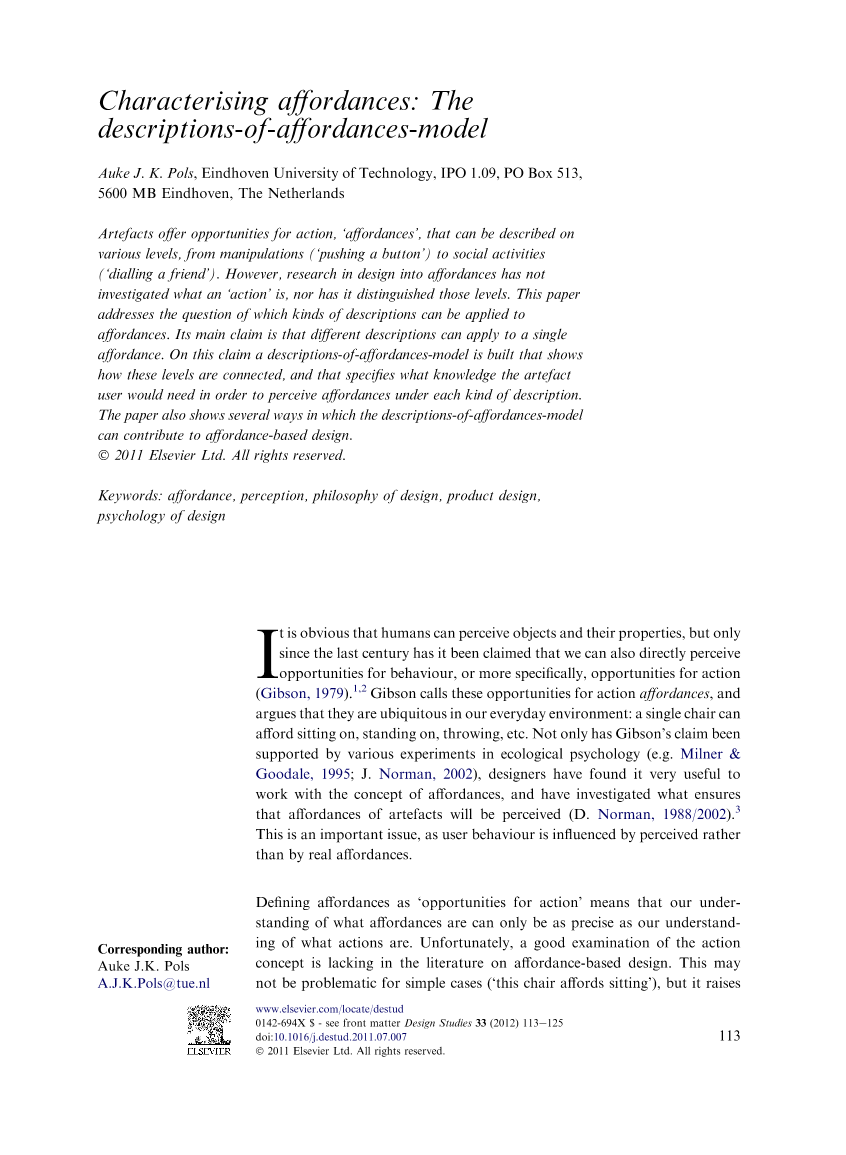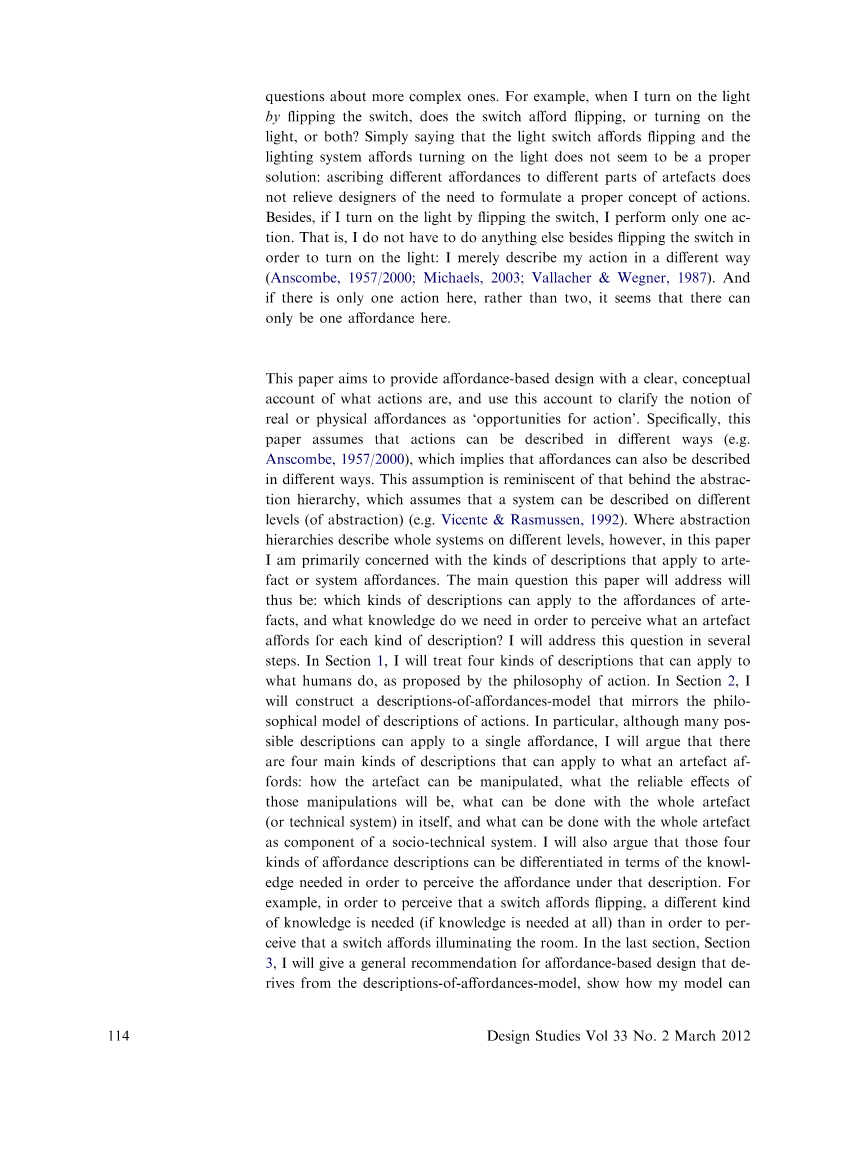

英语原文共 13 页,剩余内容已隐藏,支付完成后下载完整资料
英文原文:
Characterising affordances: Thedescriptions-of-affordances-model
Auke J. K. Pols
Eindhoven University of Technology, IPO 1.09, PO Box 513,5600 MB Eindhoven, The Netherlands
Keywords: ffordance, perception, philosophy of design, product design,psychology of design
Abstract. Artefacts offer opportunities for action, lsquo;affordancesrsquo;, that can be described onvarious levels, from manipulations (lsquo;pushing a buttonrsquo;) to social activities(lsquo;dialling a friendrsquo;). However, research in design into affordances has notinvestigated what an lsquo;actionrsquo; is, nor has it distinguished those levels. This paperaddresses the question of which kinds of descriptions can be applied toaffordances. Its main claim is that different descriptions can apply to a singleaffordance. On this claim a descriptions-of-affordances-model is built that showshow these levels are connected, and that specifies what knowledge the artefactuser would need in order to perceive affordances under each kind of description.The paper also shows several ways in which the descriptions-of-affordances-modelcan contribute to affordance-based design.
It is obvious that humans can perceive objects and their properties, but onlysince the last century has it been claimed that we can also directly perceiveopportunities for behaviour, or more specifically, opportunities for action(Gibson, 1979).1,2Gibson calls these opportunities for actionaffordances, andargues that they are ubiquitous in our everyday environment: a single chair canafford sitting on, standing on, throwing, etc. Not only has Gibsonrsquo;s claim beensupported by various experiments in ecological psychology (e.g.Milner amp;Goodale, 1995;J. Norman, 2002), designers have found it very useful towork with the concept of affordances, and have investigated what ensuresthat affordances of artefacts will be perceived (D.Norman, 1988/2002).3This is an important issue, as user behaviour is influenced by perceived ratherthan by real affordances.
Defining affordances as lsquo;opportunities for actionrsquo; means that our under-standing of what affordances are can only be as precise as our understand-ing of what actions are. Unfortunately, a good examination of the actionconcept is lacking in the literature on affordance-based design. This maynot be problematic for simple cases (lsquo;this chair affords sittingrsquo;), but it raisesquestions about more complex ones. For example, when I turn on the lightbyflipping the switch, does the switch afford flipping, or turning on thelight, or both? Simply saying that the light switch affords flipping and thelighting system affords turning on the light does not seem to be a propersolution: ascribing different affordances to different parts of artefacts doesnot relieve designers of the need to formulate a proper concept of actions.Besides, if I turn on the light by flipping the switch, I perform only one ac-tion. That is, I do not have to do anything else besides flipping the switch inorder to turn on the light: I merely describe my action in a different way(Anscombe, 1957/2000; Michaels, 2003; Vallacher amp; Wegner, 1987). Andi f there is only one action here, rather than two, it seems that there canonly be one affordance here.
This paper aims to provide affordance-based design with a clear, conceptualaccount of what actions are, and use this account to clarify the notion ofreal or physical affordances as lsquo;opportunities for actionrsquo;. Specifically, thispaper assumes that actions can be described in different ways (e.g.Anscombe, 1957/2000), which implies that affordances can also be describedin different ways. This assumption is reminiscent of that behind the abstrac-tion hierarchy, which assumes that a system can be described on differentlevels (of abstraction) (e.g.Vicente amp; Rasmussen, 1992). Where abstractionhierarchies describe whole systems on different levels, however, in this paperI am primarily concerned with the kinds of descriptions that apply to arte-fact or system affordances. The main question this paper will address willthus be: which kinds of descriptions can apply to the affordances of arte-facts, and what knowledge do we need in order to perceive what an artefactaffords for each kind of description? I will address this question in severalsteps. In Section1, I will treat four kinds of descriptions that can apply towhat humans do, as proposed by the philosophy of action. In Section2,Iwill construct a descriptions-of-affordances-model that mirrors the philo-sophical model of descriptions of actions. In particular, although many pos-sible descriptions can apply to a single affordance, I will argue that thereare four main kinds of descriptions that can apply to what an artefact af-fords: how the artefact can be manipulated, what the reliable effects ofthose manipulations will be, what can be done with the whole artefact(or technical system) in itself, and what can be done with the whole artefactas component of a socio-technical system. I will also argue that those fourkinds of affordance descriptions can be differentiated in terms of the knowl-edge needed in order to perceive the affordance under that description. Forexample, in order to perceive that a switch affords flipping, a different kindof knowledge is needed (if knowledge is needed at all) than in order to per-ceive that a switch affords illuminating the room. In the last section, Section3, I will give a general recommendation for affordance-based design that de-rives from the descriptions-of-affordances-model, show how my model canground and specify existing recommendations like lsquo;give feedbackrsquo;, and canextend the scope of affordance-based design to socio-technical systems.
1 Four ways to describe what humans do
We do many things each day: sit, stand, sneeze, blink, go to work, switch onthe light, read and send emails, prepare
剩余内容已隐藏,支付完成后下载完整资料
资料编号:[259274],资料为PDF文档或Word文档,PDF文档可免费转换为Word
以上是毕业论文外文翻译,课题毕业论文、任务书、文献综述、开题报告、程序设计、图纸设计等资料可联系客服协助查找。


